The bullets fired on May 13, 1981 by the Turkish extremist Ali Ağca were aimed at Pope John Paul II. But it wasn't just him that hit. There were other victims of this attack. Victims much too little has been said and written about.
The weather on Wednesday, May 13, 1981 was good. On St. Peter's Basilica in Rome was shining with a pleasant spring sun. The faithful came there from the very morning, wanting to take good places before the weekly audience of Pope John Paul II. It started punctually at 17. An open papamobile drove in from the side of the Bell Tower. In its back stood John Paul II, who greeted the audience with a smile. The car moved slowly between sectors and made frequent stops so that the Pope could shake hands extended to him and bless the children.
The hum of picked up pigeons
When the car was near the Bronze Gate, there was a roar of two successive shots. Dozens of pigeons occupying the surrounding rooftops and Bernini's colonnade screamed into the air. A scream of terrified people echoed across the square. A slim young Turk standing in the second row of the faithful in Sector E fired a 9mm Browning pistol twice. Two projectiles, invisible to the human eye, went towards the Pope at 350 meters per second.
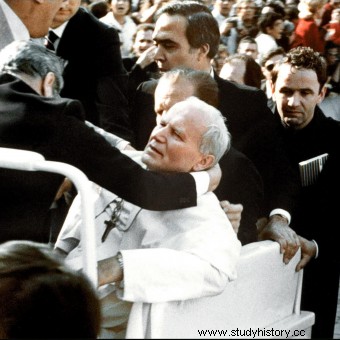
Did only John Paul II suffer on May 13, 1981?
The bomber fired a third time, but this time the pistol jammed and the bullet did not leave the barrel. John Paul II was hit in the finger of the left hand, right elbow and stomach. Blood stained the white cassock. By a twist of fate - or by God's will - the bullets bypassed the spinal cord and the main artery. The Pope fell to the floor of the car. The assassin, 23-year-old Turkish extremist Mehmet Ali Agca, was captured at the crime scene.
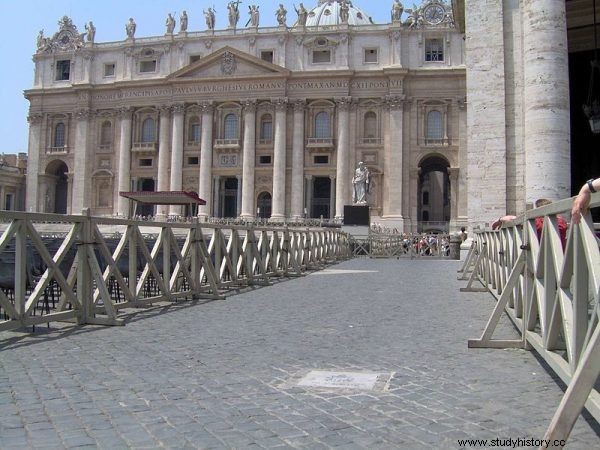
At this point the bullets fired by Ali Ağca reached the Pope.
The bullets hit not only the Pope, however. There were more victims of the attack. They also reached two other people - Rose Hall and Ann Odre. Ali Ağca, escaping from the court in a police escort, shouted to journalists:"I am sorry for the two foreign tourists, but I do not regret the Pope!" How many people actually died during the attack on John Paul II?
The bullet shattered the bones
Rose Hall was 21 years old, from the United States, but lived in Würzburg, West Germany. Her husband, Ken Hall, was a pastor. On May 13, 1981, Rose stood among the crowd of believers in St. Peter. She had a camera with her and wanted to take the best photo of the Pope. Therefore, she stood on a plastic chair to be above the heads of the crowd pressing against the railings. This is how Rose's experience is described by Jacek Tacik in his book about the attack on John Paul II, entitled "Assassination":
I was about to take a picture when I felt a burning sensation in my left hand. My elbow, almost resting on the head of a few-year-old boy standing on the ground, was on fire from the inside. I only felt pain. The bullet shattered my bones. If it were a few centimeters lower, it would have missed me and would have punctured the child's forehead. I glanced in horror at my mother standing next to me. I whispered, "I'm hurt." And I lost my balance. There was a commotion. The Swiss guards grabbed my arms. They helped to get to the ambulance, although I was walking on my own. I was awake. I remember people's terrified and teary faces, screaming and prayers.
Forty-seat room
Rose Hall did not go to the Gemelli Polyclinic like the Pope, but to the regular Holy Spirit Hospital. She was lying in a forty-seat room among patients groaning with pain. Nurses were running between the beds, doctors smoking cigarettes and shaking ashes on the floor, and no one on staff spoke English. However, she was quickly moved to a double room.
After a few days, she found her way to the operating table. The delay was caused by the waiting for the arrival of a surgeon from Naples, supposedly the best specialist in Italy. The surgeon took bone from Hall's wrist and filled the defect in the elbow with it. New York City doctors who examined her a year later said he did an excellent job. Despite this, as reported by Jacek Tacik, the American woman has not regained full power in her hand to this day, and her elbow hurts at every sudden change in the weather.
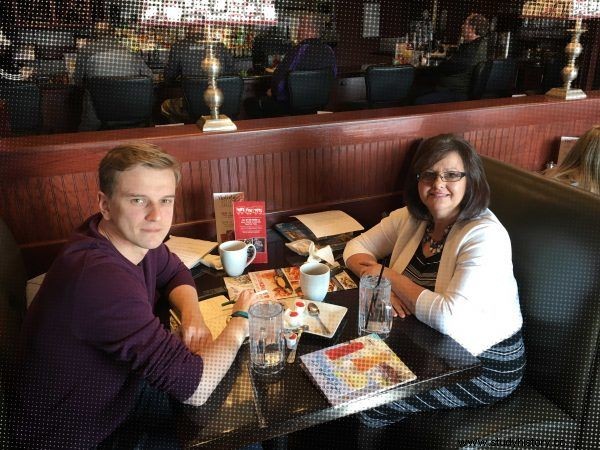
Rose Hall in conversation with Jacek Tacik.
Rose spent two weeks in the hospital. On May 24, she and her mother traveled to the Gemelli Polyclinic to meet the Pope who wanted to meet her. The Holy Father was weak and emaciated. The finger of his left hand was stiffened and bandaged. The conversation wasn't long. Finally, the Pope presented Rose and her mother with commemorative medals. The American woman never returned to Rome.
Wonderful coincidence or mistake?
The second person hit by the missile fired by Ali Ağca was 58-year-old tourist from the United States, Ann Odre. She came with a group of pilgrims from Buffalo. Ann was of Polish descent, her full name was Odrzywolski.
Polish journalists wrote that she was born in the same place and at the same time as John Paul II:on May 18, 1920 in Wadowice. It was supposed to be another miraculous coincidence related to the attack. Meanwhile, as Jacek Tacik established in an interview with Ann's daughter, Joanne Kenjarski, she was born in the USA and was three years younger than John Paul II ... On the other hand, her mother, Joanne's grandmother, came from Wadowice.
A nightmare hospital
Ann also stood on a plastic chair and also tried to take a picture of the Pope. The bullet fired by Ağca struck Rose Hall's elbow, then changed direction, hit Ann Odre in the chest and passed on. He damaged the large intestine, diaphragm and pancreas. Odra fell to the ground. Her condition was severe. She was taken to the Holy Spirit Hospital. When Joanne's daughter came to her, she was terrified of the conditions there.
There were cats running around the hospital corridors, there were no toilets in the bathrooms, only holes in the ground. Look at this picture:there are nurses at the table on duty, playing cards and smoking cigarettes. How were they supposed to heal? The needles were rusted, and the oxygen cylinders were unregulated. The hospital was equipped with a portable x-ray machine which was very old - she told Jacek Tacik.
80,000 dollars for transport
Ann has undergone two major surgeries. During the first one, Italian doctors did not notice that the bullet had damaged the colon and, as a result, an infection had occurred. During the second, the colonoscopy was carried out inaccurately. For lunch and dinner, the injured woman had hard-to-digest meals:thick soups and chickens in garlic sauce. These were torments for the diseased organism. Ann spent 23 days in hospital.
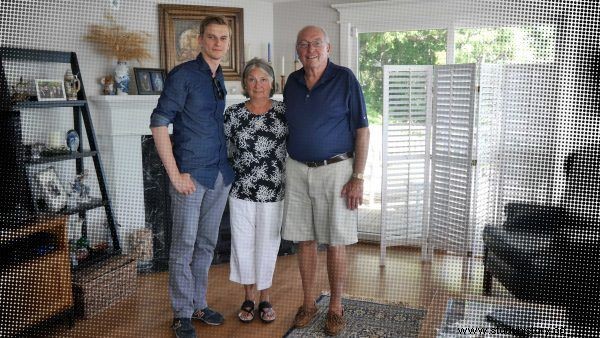
Jacek Tacik at the meeting with Joanne Kenjarski - daughter of Ann Odre - and her husband Thomas.
As Joanne Kenjarski reports in the book by Jacek Tacik, the stay in Italy was a nightmare. The American authorities did not give her any help, and demanded 80,000 zlotys for the transport of the injured mother to the USA. dollars. The Italians did not provide any information, and besides, it was difficult to communicate in the hospital because no one spoke English. Joanne had to hide all the time from American journalists who constantly demanded interviews and statements.
She came close to death
On June 4, Ann Odre was invited to meet John Paul II in the library of the Apostolic Palace. It was only there that the Pope found out that Ann had been injured much more severely than he was and that she had rubbed herself to death.
- I'm sorry you are suffering for me - He said. My mother looked the Holy Father in the eye and whispered in a weak voice:"I always wanted to see His Holiness up close. He has such a beautiful face. I would like to touch her. " John Paul II leaned over her wheelchair:"Please do it" - says Joanne Kenjarski.
Call from the prosecutor's office
Despite her mother's poor condition, Joanne decided to transport her to the USA. The Italian side demanded that documents be signed in which the daughter took responsibility for this decision. The flight was via London, where the controllers were on strike, so the journey was delayed by several hours.
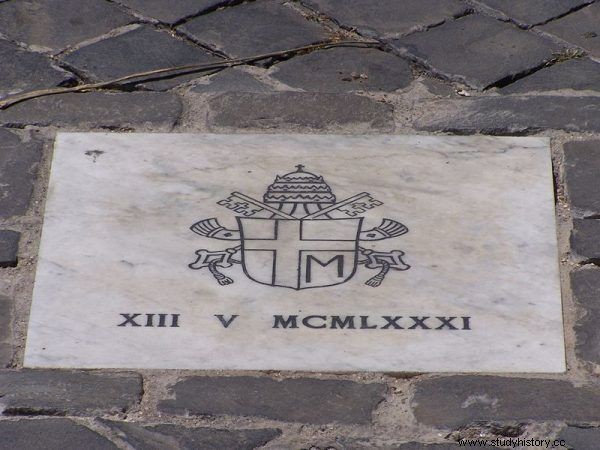
Plaque commemorating the site of the attack in St. Peter.
In the USA, Ann Odre underwent a third operation, during which the negligence of Italian surgeons was corrected - the abscess from the abdominal cavity and a fragment of the infected large intestine were removed, and the stoma was also moved. In the hospital it turned out that Ann was infected with a stick of blue pus, resistant to the antibiotics used. Only the use of an experimental drug - piperacillin - was it possible to cure it. She returned home on July 13, two months after the attack.
Some time later, she was summoned to be questioned by the Italian prosecutor's office. For the flight to Rome and the stay she was supposed to pay out of her own pocket ... Ann Odre died on March 6, 1997 at the age of 73.
